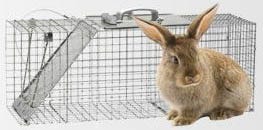Trapping 101
In this section, Havahart® provides general live animal trapping information. You’ll find an overview of how to trap animals, different trap types, and answers to your most common animal trapping questions!

How to Bait a Live Animal Trap
One of the most important steps in the live animal trapping process is baiting your trap. Baiting your live animal trap serves two purposes: luring your animal into the trap, and encouraging it to engage the trigger.
Learn how to bait a live animal cage trap by following the below steps from Havahart®. For more trapping tips, read How to Trap »

1 Select a Bait
In order to lure your animal into the trap, you must select an attractive bait. The best bait to use varies with each target animal. Expert suggestions for some of the most commonly trapped animals include:
- raccoons: marshmallows
- rabbits: cabbage
- squirrels or chipmunks: peanuts
- groundhogs: cantaloupe
- skunks or opossums: canned fish
- feral cats: cat food
For more animal-specific recommendations, visit the Animal How-To page and select your critter.
TIP: If you aren't sure exactly what kind of animal you want to trap, try a bait that attracts most animals - like peanut butter.

2 Wear Gloves
Avoid transferring your scent to the bait or to the trap by wearing gloves whenever handling them. Any trace of a human's scent may deter an animal from entering your live trap.
3 Carefully Position Your Bait
While selecting the right bait will help attract your animal to the trap, only careful positioning of the bait will lead to a successful capture.
The best bait placement will:
- Force the animal to fully enter the trap to reach it.
- Encourage the animal to engage the trigger.
- Take into consideration the trap type (1 vs. 2-door):
1 Door

Place your bait at the back-end of the trap - just beyond the trigger plate. Try to keep it as far from the trap walls as possible so an animal cannot steal the bait.
2 Door

Position your bait towards the center of the trap, luring the animal directly to the trigger plate. You can either place the bait directly onto the plate, hang it from the top of the trap directly above the plate, or place it in a hole in the ground directly underneath the plate.

4 Force Interaction
An animal may be more likely to engage the trigger if you make the animal work for the bait. Spread peanut butter directly onto the plate and place additional bait in the sticky substance for the animal to dig out.
Tip: You can also place bait inside a piece of PVC tubing and hang it from the top of your trap, creating a challenge for the animal.

5 Create a Bait Trail
Make your trap even more enticing by creating a trail of bait leading to the entrance. A bait trail will not only guide your animal to the cage but will give it a taste of the bait inside, motivating it to enter.
Tip: Identify an animal's home (i.e. a nest, burrow, tree, brush pile or structure) and place bait directly next to it. Then create a bait trail leading from this area to your trap, which should be positioned only a few feet away.

6 Introduce Your Trap
Use bait to help your animal become comfortable with the trap before you set it up for a catch. Bait your trap, then tie or prop the door(s) open so that the trap cannot be triggered closed. Once you notice the bait inside the trap has been eaten, remove the ties so that the next time your animal enters, the doors will close.
Expert Tips
- For more animal-specific bait information and trapping tips, select your animal from the Havahart® Animal How-To Page.
- If your target animal has a preference for particular fruits, veggies, plants, seeds or nuts from your yard, try baiting your trap with these before resorting to your pantry.
- Selecting bait that is larger than the trap openings will help prevent animals from stealing bait from outside of the trap.
- Prevent an animal from knocking the trap over and stealing the bait by placing a brick or weight on top to keep it anchored down.
- Make sure that your bait does not get in the way of the trap's trigger mechanism; the area below the trigger pan should be clear of food and debris. Test your trap by pressing the pan with a pen or stick - the doors should quickly shut without much force.
Video: Baiting a Live Trap
A Havahart® trapping expert offers advice on baiting your live animal trap.
